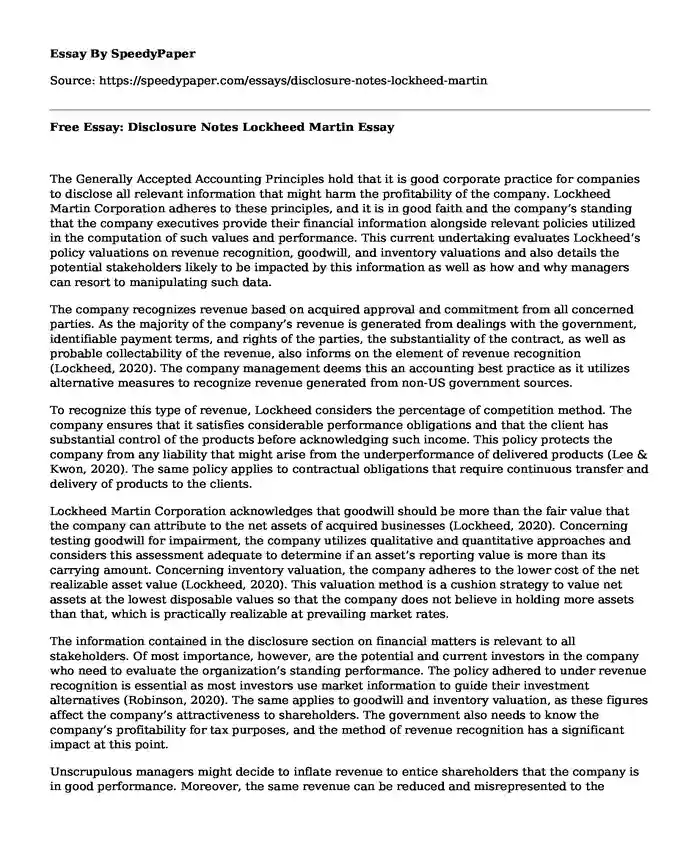
| Type of paper: | Essay |
| Categories: | Company Data analysis Audit Accounting |
| Pages: | 3 |
| Wordcount: | 632 words |
The Generally Accepted Accounting Principles hold that it is good corporate practice for companies to disclose all relevant information that might harm the profitability of the company. Lockheed Martin Corporation adheres to these principles, and it is in good faith and the company’s standing that the company executives provide their financial information alongside relevant policies utilized in the computation of such values and performance. This current undertaking evaluates Lockheed’s policy valuations on revenue recognition, goodwill, and inventory valuations and also details the potential stakeholders likely to be impacted by this information as well as how and why managers can resort to manipulating such data.
The company recognizes revenue based on acquired approval and commitment from all concerned parties. As the majority of the company’s revenue is generated from dealings with the government, identifiable payment terms, and rights of the parties, the substantiality of the contract, as well as probable collectability of the revenue, also informs on the element of revenue recognition (Lockheed, 2020). The company management deems this an accounting best practice as it utilizes alternative measures to recognize revenue generated from non-US government sources.
To recognize this type of revenue, Lockheed considers the percentage of competition method. The company ensures that it satisfies considerable performance obligations and that the client has substantial control of the products before acknowledging such income. This policy protects the company from any liability that might arise from the underperformance of delivered products (Lee & Kwon, 2020). The same policy applies to contractual obligations that require continuous transfer and delivery of products to the clients.
Lockheed Martin Corporation acknowledges that goodwill should be more than the fair value that the company can attribute to the net assets of acquired businesses (Lockheed, 2020). Concerning testing goodwill for impairment, the company utilizes qualitative and quantitative approaches and considers this assessment adequate to determine if an asset’s reporting value is more than its carrying amount. Concerning inventory valuation, the company adheres to the lower cost of the net realizable asset value (Lockheed, 2020). This valuation method is a cushion strategy to value net assets at the lowest disposable values so that the company does not believe in holding more assets than that, which is practically realizable at prevailing market rates.
The information contained in the disclosure section on financial matters is relevant to all stakeholders. Of most importance, however, are the potential and current investors in the company who need to evaluate the organization’s standing performance. The policy adhered to under revenue recognition is essential as most investors use market information to guide their investment alternatives (Robinson, 2020). The same applies to goodwill and inventory valuation, as these figures affect the company’s attractiveness to shareholders. The government also needs to know the company’s profitability for tax purposes, and the method of revenue recognition has a significant impact at this point.
Unscrupulous managers might decide to inflate revenue to entice shareholders that the company is in good performance. Moreover, the same revenue can be reduced and misrepresented to the government for taxation purposes. Especially in instances where executive compensation is based on performance reviews, most managers resort to extreme creative accounting measures to portray excellent performance. Ethically this practice is wrong and detrimental to the good standing of the organization as lawsuits might arise as well as the loss of potential future revenue when clients pull out of contracts based on unethical accounting practices of the company management.
References
Lee, N., & Kwon, K. H. (2020). Revenue recognition on the percentage of completion basis and firm value. International Journal of Business and Society, 21(1), 25-41. http://www.ijbs.unimas.my/images/repository/pdf/Vol21-no1-paper2.pdf
Lockheed Martin Corporation. (2020). Form 10-K 2019. [PDF]
Robinson, T. R. (2020). International financial statement analysis. John Wiley & Sons.
Cite this page
Free Essay: Disclosure Notes Lockheed Martin. (2023, Aug 13). Retrieved from https://speedypaper.com/essays/disclosure-notes-lockheed-martin
Request Removal
If you are the original author of this essay and no longer wish to have it published on the SpeedyPaper website, please click below to request its removal:
- Free Essay on Politics in Gethen
- Free Essay Sample on Car Wars at Wolfsburg
- Free Essay on How Social Media and Other Technologies Influences How We Worm Identities
- Physics Essay Example Describing the Experiment Based on Newton's Second Law of Motion
- Paper Example on Factors That Influence Foreign Exchange Rates
- Free Essay Sample. Innovation
- US GAAP to IFRS: Clarifications & Recommendations for Change - Paper Example
Popular categories




